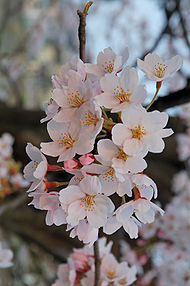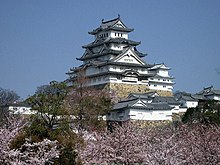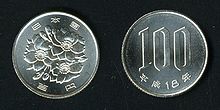Cherry Blossom
A cherry blossom is the name for the flower of cherry trees known as Sakura (Japanese kanji : 桜 or 櫻; hiragana: さくら) in Japanese. In English, the word "sakura" is equivalent to the Prunus serrulata,Japanese flowering cherry. Cherry fruit (known in Japanese as 桜んぼ sakuranbo) comes from another species of tree.
Sakura at Fukushima
Flower Viewing
The practice of hanami is many centuries old. The custom is said to have started during the Nara Period (710–794) when it was ume blossoms that people admired in the beginning. But by the Heian Period (794–1185), sakura came to attract more attention and hanami was synonymous with sakura. From then on, in tanka and haiku, "flowers" meant "sakura." The custom was originally limited to the elite of the Imperial Court, but soon spread to samurai society and, by the Edo period, to the common people as well. Tokugawa Yoshimune planted areas of cherry blossom trees to encourage this. Under the sakura trees, people had lunch and drank sake in cheerful feasts.
Every year the Japanese Meteorological Agency and the public track the sakura zensen (cherry-blossom front) as it moves northward up the archipelago with the approach of warmer weather via nightly forecasts following the weather segment of news programs. The blossoming begins in Okinawa in January and typically reaches Kyoto and Tokyo at the end of March or the beginning of April. It proceeds into areas at the higher altitudes and northward, arriving in Hokkaidō a few weeks later. Japanese pay close attention to these forecasts and turn out in large numbers at parks, shrines, and temples with family and friends to hold flower-viewing parties. Hanami festivals celebrate the beauty of the cherry blossom and for many are a chance to relax and enjoy the beautiful view. The custom of hanami dates back many centuries in Japan: the eighth-century chronicle Nihon Shoki (日本書紀) records hanami festivals being held as early as the third century CE.
Most Japanese schools and public buildings have cherry blossom trees outside of them. Since the fiscal and school year both begin in April, in many parts of Honshū, the first day of work or school coincides with the cherry blossom season.

Sakura at Tokyo Imperial Palace

Sakura within a field of Phlox subulata at Yachounomori Garden in Tatebayashi, Gunma

At Himeji Castle Japan
Symbolism
In Japan cherry blossoms also symbolize clouds due to their nature of blooming en masse, besides being an enduring metaphor for the ephemeral nature of life, an aspect of Japanese cultural tradition that is often associated with Buddhistic influence, and which is embodied in the concept of mono no aware. The association of the cherry blossom with mono no aware dates back to 18th-century scholar Motoori Norinaga. The transience of the blossoms, the extreme beauty and quick death, has often been associated with mortality; for this reason, cherry blossoms are richly symbolic, and have been utilized often in Japanese art, manga, anime, and film, as well as at musical performances for ambient effect. The band Kagrra, which is associated with the visual kei movement, is an example of this latter phenomenon. There is at least one popular folk song, originally meant for the shakuhachi (bamboo flute), titled "Sakura", and several pop songs. The flower is also represented on all manner of consumer goods in Japan, including kimono, stationery, and dishware.
Cherry blossom is an omen of good fortune and is also an emblem of love, affection and represents spring. Cherry blossoms are an enduring metaphor for the fleeting nature of life, and as such are frequently depicted in art.
During World War II, the cherry blossom was used to motivate the Japanese people, to stoke nationalism and militarism among the populace. Japanese pilots would paint them on the sides of their planes before embarking on a suicide mission, or even take branches of the trees with them on their missions. A cherry blossom painted on the side of the bomber symbolized the intensity and ephemerality of life; in this way, the aesthetic association was altered such that falling cherry petals came to represent the sacrifice of youth in suicide missions to honor the emperor. The government even encouraged the people to believe that the souls of downed warriors were reincarnated in the blossoms.
In its colonial enterprises, imperial Japan often planted cherry trees as a means of "claiming occupied territory as Japanese space".

Woodblock print of Mount Fuji and cherry blossom from 36 Views of Mount Fuji by Hiroshige.

A 100 yen coin depicting Cherry Blossom
Varieties and blooming
The most popular variety of sakura in Japan is the Somei Yoshino. Its flowers are nearly pure white, tinged with the palest pink, especially near the stem. They bloom and usually fall within a week, before the leaves come out. Therefore, the trees look nearly white from top to bottom. The variety takes its name from the village of Somei (now part of Toshima in Tokyo). It was developed in the mid- to late-19th century at the end of the Edo period and the beginning of the Meiji period. The Somei Yoshino is so widely associated with cherry blossoms that jidaigeki and other works of fiction often depict the variety in the Edo period or earlier; such depictions are anachronisms.
Winter sakura (fuyuzakura/Prunus subhirtella autumnalis) begins to bloom in the fall and continues blooming sporadically throughout the winter. It is said to be a cross between Tokyo Higan cherry (edohiganzakura/P. incisa) andMamezakura/P. pendula.
Other categories include yamazakura, yaezakura, and shidarezakura. The yaezakura have large flowers, thick with rich pink petals. The shidarezakura, or weeping cherry, has branches that fall like those of a weeping willow, bearing cascades of pink flowers.
Culinary use
Cherry blossoms and leaves are edible and both are used as food ingredients in Japan. The blossoms are pickled in salt and umezu and used for coaxing out flavor in wagashi or anpan. Salt-pickled blossoms in hot water is called sakurayu and drunk at festive events like weddings in place of green tea. Leaves, mostly Ōshima cherry because of the softness, are also pickled in salted water and used for sakuramochi. Since the leaves contain coumarin, however, it is not recommend to eat them in great quantity.

Pickled blossoms

A cup of Sakurayu
Cherry blossoms in other countries
Canada
Germany
Philippines
South Korea
Turkey
United Kingdoms
United States
![[J-BLOG] Map, Culture & Traditional, Etc.](https://blogger.googleusercontent.com/img/b/R29vZ2xl/AVvXsEhvmfEXojE4IaQHEj7WJFFqXpc3QG9Ha9bRblYtkTG45gtZEvAQVzCYNBMEk9AZt7shLWsSI-b7qM1JKgtTeaxkQC4cI557LmRMY40UOkXKjybg3WIIVXCrwdfnFlpWjha0CFeeTp9DPSk/s1600-r/j-blog_banner.png)
No comments:
Post a Comment